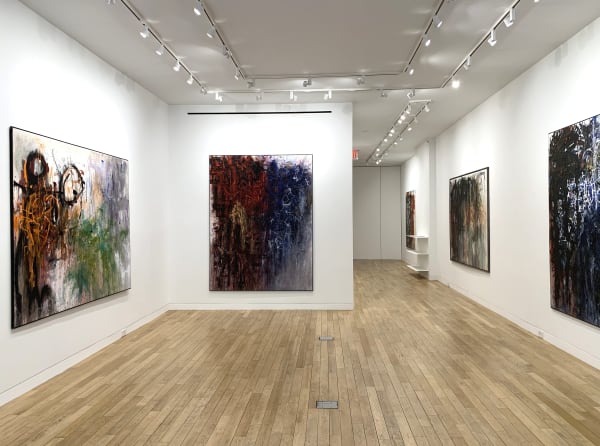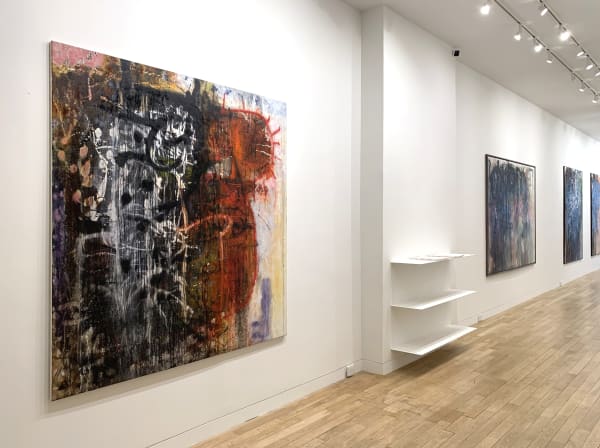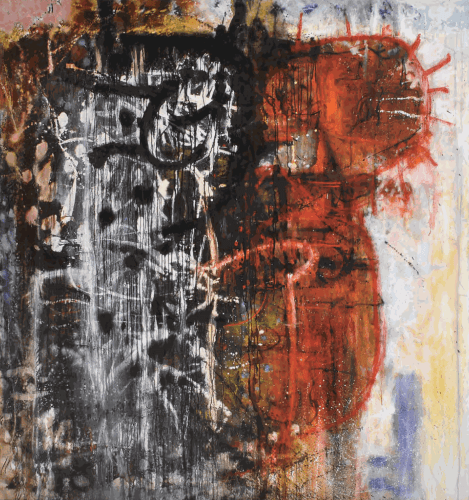Clyde Hopkins: Chaunticlere: Paintings from the 80s
NEW YORK, NY – Upsilon Gallery is pleased to announce an exhibition of seminal paintings by the late British artist Clyde Hopkins (1946-2018) titled Chaunticlere: Paintings from the 1980s, on view from April 22 to June, 11, 2022. Presented in cooperation with the artist’s estate, this group of works places enormous value on emotional spontaneity, instinctive creation and scale in response to political and social issues in the wake of Thatcherism. This exhibition marks the first showing of Hopkins’ artworks with Upsilon Gallery in New York. An opening reception will be held at 23 East 67th Street on Thursday, April 21, from 6:00–8:00 PM.
Stylistically linked to many of the most important art movements of his time, Hopkins’ legacy is his large and diverse body of work, expressing both abstraction and early referents to representation in imaginative, surprising and lyrical ways. Throughout his life and career, Hopkins drew his inspiration from one of his greatest passions: nature. In the paintings selected for this exhibition, Hopkins demonstrated visceral attitudes toward the then political and social climate in the UK. Even though abstraction was apparent, landscape and the natural world were still important and acted as a starting point, as is evident in the pictures, Reluctance: State Peach (1984), The Diary and the Coast (1985), and Diving for Pearls (1986). The covert reference in the titles to a moment of political confrontation was manifest in the turbulent nature of the paintings.
Hopkins combined Abstract Expressionism’s active gestures and freedoms with the intuitive approach to composition he had been developing. He worked instinctively, yet methodically—these works represent the evolution of his skill as a painter. It speaks to his ability to create volume in space, his mastery of color and his ability to harness the stark emotive power suggesting an attempt to access a kind of thought-before-words, uncorrupted by the socialized realm of language.
About this selection of paintings, Metropolitan Museum of Art curator John Guy notes, “[They] represent Hopkins’ intensely personal psychological journeying, that is at once dangerous and inviting. Whilst venturing far from shore, Hopkins always extended a lifeline to his viewer, a glimpse of something that just might be a remembering of something figurative, a powerful idea, or a quirky title that evoked its own sense of place, or, of a moment experienced, made unexpectedly familiar.”
Guy goes on, “[They] have another quality not immediately apparent at first glance: they are deeply pleasurable. Colours have a remarkable intensity, a dark ominous blue or impasto black verging on the foreboding, creating a tension that is then relieved on occasion by grid structures or by arabesques that cartwheel across the composition. Light blues and whites are given the luminous effervescence of reactive minerals, radiating off the dark dense canvas. Others have a lighter mood, curlicues that evoke a memory of Matisse’s balcony, with the atmosphere of a balmy Mediterranean summer night. In Hopkins abstractions, you always stay connected, no matter how tenuously, with the material world.”
About Clyde Hopkins
Clyde Hopkins was born in East Sussex in 1946 and moved with his family to Cumbria when he was 11, before studying fine art at Reading in the 1960s where he met his future wife, Marilyn. He exhibited work for over 40 years, produced in studios in Greenwich, Deptford and St. Leonards-on-Sea. During his life, Clyde was awarded the Mark Rothko Memorial Fellowship (USA) in 1990-91 and the 1999 Lorne Award. Widely admired as a generous teacher and mentor, he was a visiting artist in many art schools during the 1970s until becoming Head of Painting, then of Fine Art, at Winchester School of Art in 1982. From 1990 to 2006 he was Head of Painting at Chelsea College of Art and Design, London, and retired as emeritus professor at the University of the Arts London. After his death in 2018, some of his works were acquired by the Tate.
Solo exhibitions included the Serpentine Gallery London (1978 and 1986), the Acme Gallery London (1979), the Ikon Birmingham and Rochdale Art Gallery (both 1985), Salisbury Art Centre (1988), Modern Times at the Castlefield Gallery Manchester (1989), Kunstverein Kirchzarten Germany (Kunst Europa 1991), Reg Vardy Arts Foundation Sunderland (1994), Atkinson Gallery Millfield School (1996), Vodka, a Stiff Breeze and Paranoia at the London Institute Gallery (1998), the Francis Graham Dixon Gallery London (1989, 1990, 1992, 1994, 1997) and Galeria Joan Prats New York (1990 and 1994). In 2012, he had two solo exhibitions—Brown Madder at Chelsea Futurespace, London, and Indian Yellow at the Merston Gallery, Chichester.
Upsilon Gallery is located at 23 East 67th Street, New York NY 10065. Exhibition hours are Monday to Friday 10:00 AM–6:00 PM, Saturday by appointment. Please contact the gallery at (646) 476-4190 or email at info@upsilongallery.com for further details.
For additional information and media inquiries, please contact:
R. Couri Hay or Sarah Gartner at R. Couri Hay Creative PR
tel +1 (212) 580-0835
email couri@rcourihaycpr.com, sarah@rcourihaycpr.com.
As a painter and an educator Clyde Hopkins had a profound and lasting influence on all those around him - an influence which continues to be assessed today with his recent inclusion in the Tate Collection, and solo shows this year in the UK and New York. As the weight and significance of his work is brought to light through exhibition and publication, it becomes increasingly clear that his contribution to contemporary painting, and abstraction in particular, was extraordinary.
Chaunticlere, paintings from the 80’s focuses on a particular period of Clyde’s practice.
Beginning in the mid-80s, earlier “non-tactile forms were replaced by much more aggressive and interactive elements... The change took place around late 1983 and the results were displayed in an exhibition of new paintings that toured nationally between late 1985 and the spring of the following year. A notable innovation was heavy black drawing creating a structure that spread throughout the painting like a burnt root system, particularly visible in Kent to Yorkshire (via the D.T.) (1984) [currently in the Tate collection]. That the structure resembles a chain of letters, albeit consisting of a limited alphabet, suggests that the works may contain hidden messages, once legible, but scattered and garbled when subjected to a highly active painting process.” Clyde Hopkins- A path through dark and light. David Sweet.
It is fitting that these paintings are shown now in New York, as a visit by Hopkins to New York
in 1984 had a profound influence on him. As noted in an essay written by Brandon Taylor in
1985 on this period of Clyde’s painting, a “…major influence on Hopkins has been American
abstraction. The very scale of his paintings gives this away - as do the paintings of many of his generation in England. It derives from that impossible hybrid invented by Jackson Pollock and his school- the portable mural: a cross between an architectural decoration and a marketable object. Pre-eminently, however, it is the concept of art-as-action that is relevant here - the swirl of the arm, the dripped paint, the degree of "movement" in the drawing. Approached from another direction, it was the expressionist scribble - of Soutine, of Picasso that became connected in the American mind with a certain concept of the unconscious, such as that it was irrational, free, instinctive, and capable of extreme violence. This was broadly speaking the way in which the rapid, messy style of abstract expressionist painting came to be viewed as "action" by its left-wing supporters such as Harold Rosenberg. The concept of a painting as "an arena in which to act" is his; "the painter no longer approached his easel with an image in his mind; he went up to it with material in his hand to do something to that other piece of material in front of him”.







